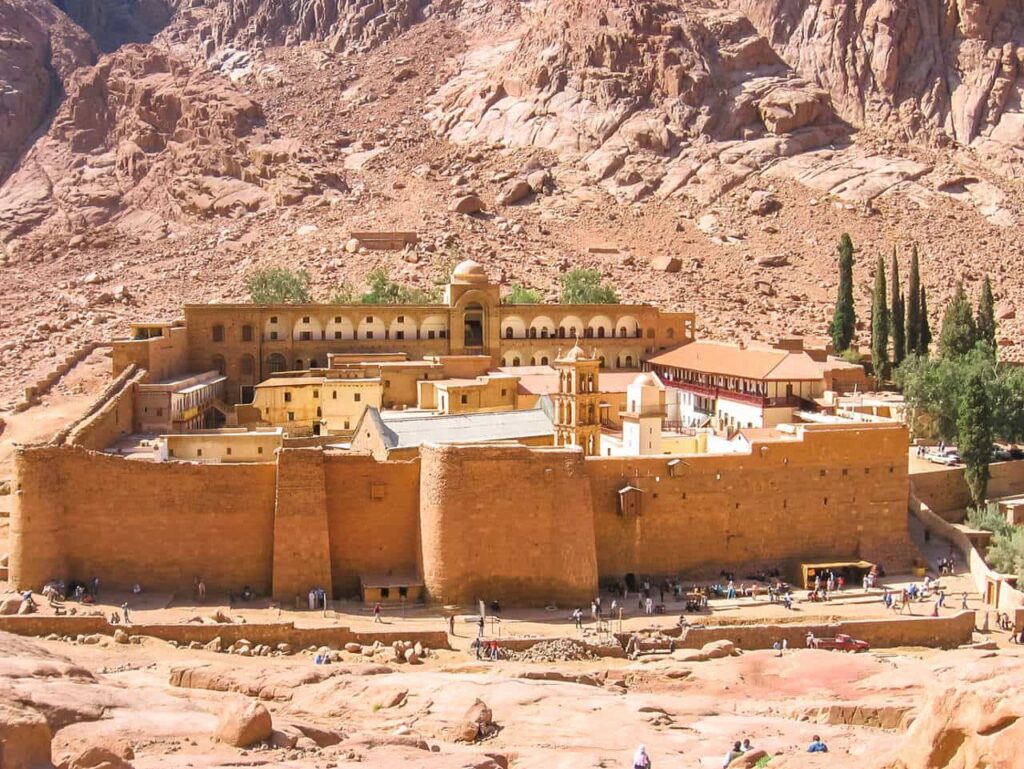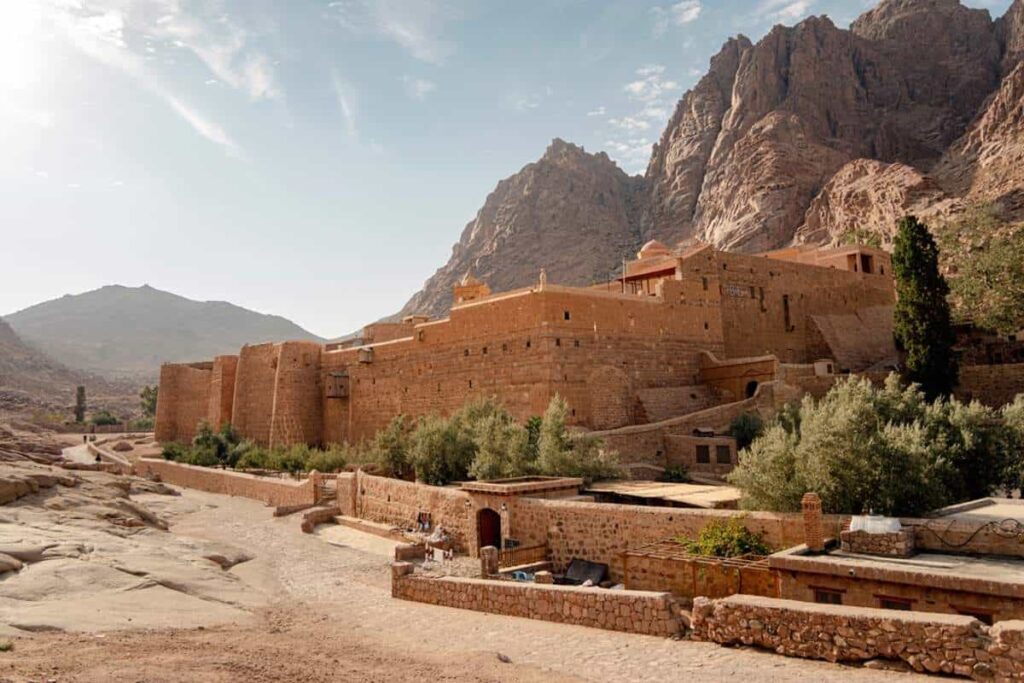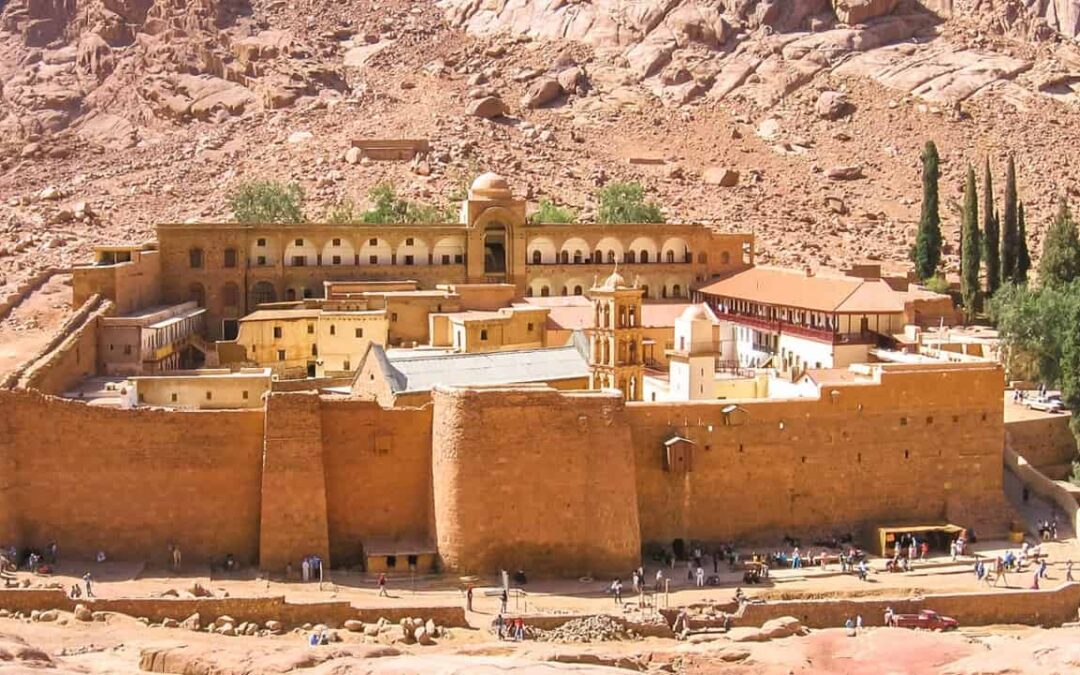Nestled within a majestic canyon, casting its imposing silhouette against the backdrop of Mount Sinai, lies a sanctuary steeped in profound spirituality and rich history. Saint Catherine’s Monastery, renowned as the Transfiguration Monastery, stands as a testament to the ages, its foundations laid in 565 AD by the decree of Emperor Justinian I with the noble intention of safeguarding a sacred chapel.
This hallowed chapel occupies the very spot where ancient tradition claims Moses communed with the divine. Thus, the Monastery of Saint Catherine on Mount Sinai stands as one of the most ancient inhabited monastic complexes on Earth, an oasis where time seems to pause, inviting introspection and contemplation.
Remarkably, the monastery has remained largely unaltered since its original construction. The same venerable wooden door still adorns the western portal, while the ornate wooden ceiling, a tribute to Emperor Justinian and his esteemed consort Theodora, continues to grace the hallowed halls.
Crafted in the 6th century, these intricately carved beams bear inscriptions that have captivated the curiosity of countless travelers throughout history. It wasn’t until 1958, however, that a meticulous expedition carefully deciphered and studied the messages etched into the beams.
Their contents revealed references to the “most pious emperor,” undoubtedly alluding to Justinian, and “his late Empress,” a poignant homage to Theodora. Based on this invaluable clue, it can be deduced that the monastery was constructed between the passing of the revered empress and the emperor, specifically during the years spanning 548 to 565.
Within the hallowed grounds of the Monastery of Santa Catalina, vestiges of a mosque from the 10th and 11th centuries can still be found, attesting to the layers of history that have interwoven throughout the ages.
Additionally, the Chapel of Saint Tryphon serves as a solemn ossuary, providing a final resting place for departed monks.
This architectural tapestry represents the harmonious fusion of diverse constructions that have accumulated over time, an amalgamation made possible by the remote locale of the monastery. Perched at an altitude of 1,600 meters, it has stood as a bastion, both challenging to access and a sanctuary worth preserving.
In the 19th century, the journey to reach this sanctuary demanded a caravan of camels, along with provisions, porters, and expert guides from the nearest city of Suez, spanning a grueling ten-day traverse through the arid desert. Nevertheless, in the 1970s, a road was constructed, facilitating access and subsequently increasing the influx of visitors eager to immerse themselves in the timeless aura of the monastery.
Unveiling the Marvels of a Singular World Library
Saint Catherine Monastery stands not only as a testament to the annals of time but also harbors a secret that sets it apart—a repository of knowledge that holds an air of mystique.
Concealed within its ancient stone walls lies a library, an unparalleled treasure trove of enigmatic and age-old codices, standing as the second-largest collection in the world. Surpassed only by the Vatican Library in terms of quantity, it is a sanctuary of wisdom and ancient wisdom.
The library houses a remarkable assemblage of over 3,000 manuscripts, inscribed in languages such as Greek, Coptic, Armenian, Hebrew, Arabic, and Syriac. These diverse texts offer a tantalizing glimpse into the interconnectedness between the Far West and the Middle East during the Middle Ages, defying conventional beliefs.
Moreover, within its hallowed chambers, 12,000 ancient books reside, including 8,000 in Greek and 1,000 in Latin, while an additional 10,000 printed volumes grace its shelves.
This repository stands as a bastion of historical and cultural significance, ranking among the most esteemed libraries worldwide and boasting an enduring legacy of continuous service spanning the ages.
Delving into the depths of this fabled library, one discovers an assortment of magnificently illustrated medieval bibles, theological treatises, philosophical texts, legal documents, and correspondence from long-forgotten pontiffs and venerable religious leaders of bygone eras.
These precious tomes offer invaluable insights into the thoughts, beliefs, and intellectual endeavors of those who traversed this mortal realm countless centuries ago.
Notably, the library safeguards a collection of icons, some of which date back to the 5th and 6th centuries—an extraordinary testament to the enduring power and significance of religious artistry.
Each book harbored within this sanctuary serves as a portal to the past, bridging the divide between contemporary minds and the wisdom of the ancients.
Through the tangible pages, one can forge a palpable connection to the intellect, ideals, and aspirations of those who penned these sacred texts, transcending the boundaries of time and enriching our understanding of human history.
The Magnitude of a Palimpsest Haven
Concealed within the layers of text, linguistic treasures and historical secrets lie entwined, waiting to be unveiled. Through the employment of cutting-edge ultraviolet and infrared light techniques, these enigmatic palimpsests, adorned with nearly imperceptible remnants of ink and erasures from bygone pages, have been brought to light.
The ancient manuscripts of the world’s oldest monastery hold a captivating allure. In an era when parchment was a precious and painstakingly crafted commodity, monks would diligently erase existing texts using orange juice or meticulously scrape away the words, reclaiming the precious surface for new script.
Though the recovery of these obscured writings seemed an insurmountable challenge, modern technology has made remarkable strides. Through the laborious process of scanning the pages, nearly two hundred palimpsests have been unearthed, revealing a treasure trove of over 6,800 recovered texts.
Among the notable finds are a hundred previously unknown Greek poems and the earliest recorded recipe attributed to the revered Greek physician, Hippocrates.
The question arises: Why did such an immense collection of books amass within this secluded corner of the world?
The answer lies in the enduring existence of Saint Catherine’s Monastery, which has withstood the test of time without ever succumbing to destruction.
Over the centuries, a slow accumulation of texts occurred, perpetuated not only by the resident monks but also by the multitude of pilgrims who sought solace within Sinai’s sacred domain.
These pilgrims, hailing from distant lands, would often find respite and produce their own manuscripts, in addition to the treasured tomes they carried along on their arduous journeys.
Preservation has been paramount for the monastery’s cherished library, safeguarded meticulously over the ages, aided by the arid and remote climate of the desert. Despite the ravages of fire, pillaging, and conflict, it endures as a resolute bastion of knowledge, a testament to human resilience.
So, how do these ancient treasures find preservation in the present day?
In the early years of this century, a team of expert conservators determined that the optimal method for safeguarding the manuscripts within local conditions entailed the utilization of stainless steel boxes.
Stripped of their archival cardboard and cloth wrappings, the manuscripts found solace within these aesthetically unified casings, each tailored to accommodate the unique dimensions of the respective manuscript. Furthermore, a secondary cardboard enclosure provides an additional layer of protection.
To efficiently organize this vast collection, a specialized computer program was devised, streamlining the sorting process for the approximately 2,000 selected works. This ongoing project will span several years, with the ultimate goal of preserving this ancient library as a beacon of knowledge for future generations, transcending the bounds of time.
Saint Catherine’s Monastery stands as a testament to the indomitable spirit of preservation, safeguarding the wisdom of antiquity and illuminating the path towards future libraries that honor and cherish our collective heritage.
Source: José Alejandro Adamuz, National Geographic










